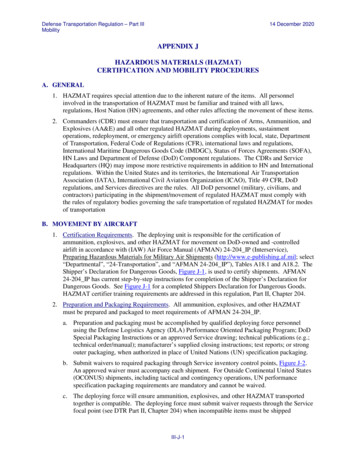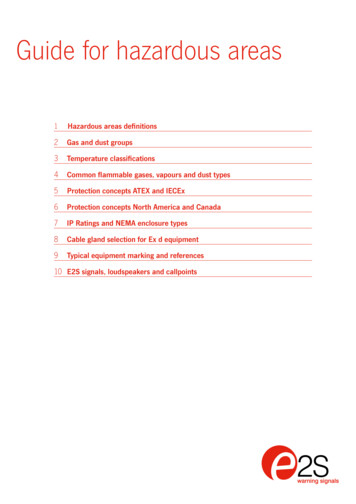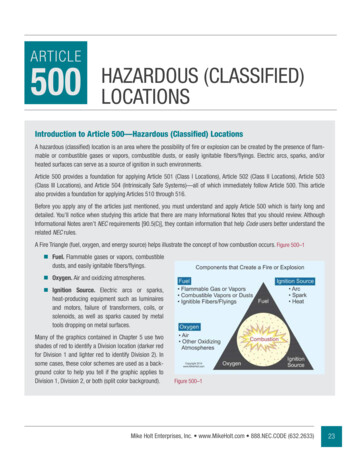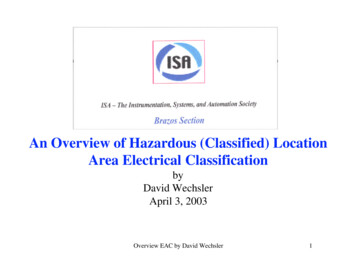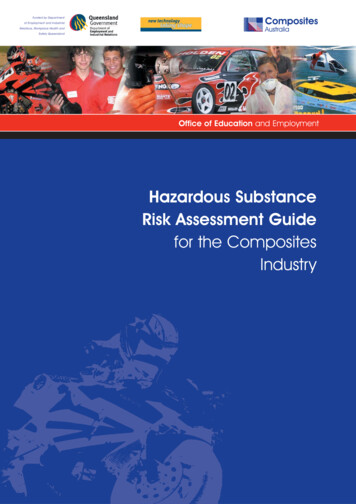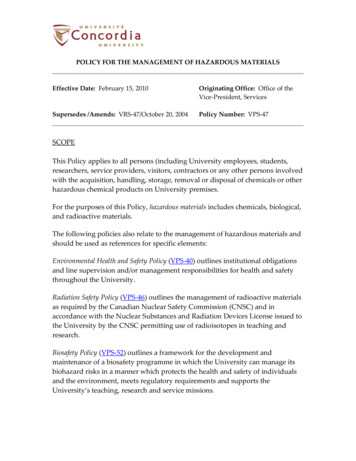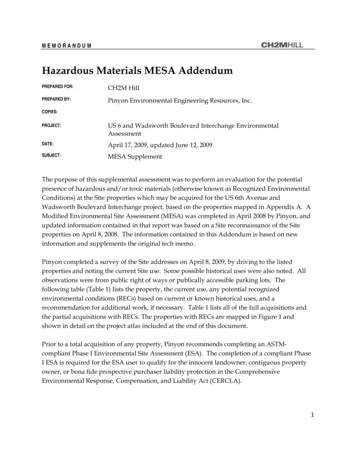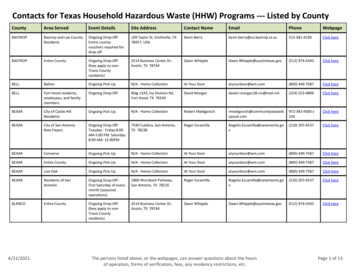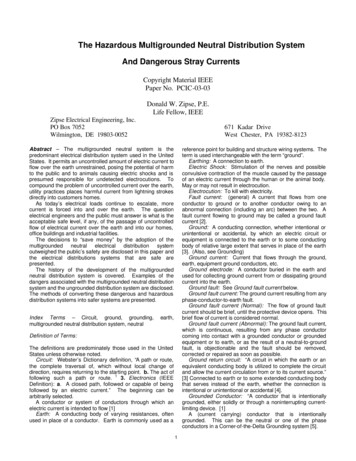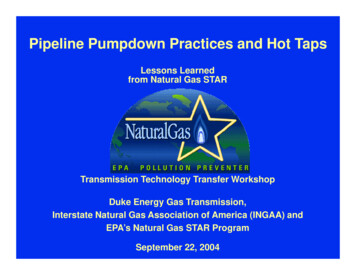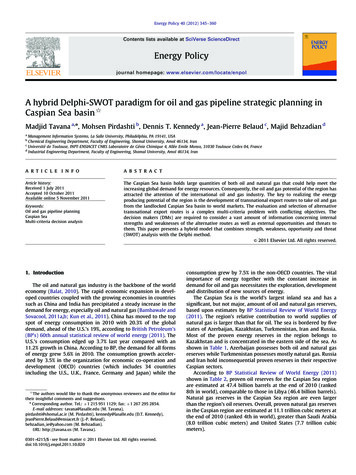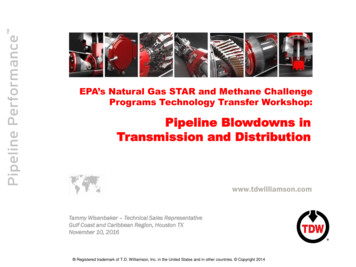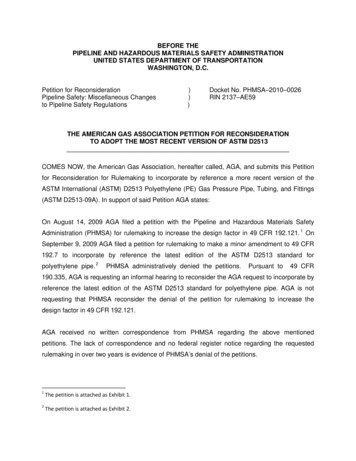
Transcription
BEFORE THEPIPELINE AND HAZARDOUS MATERIALS SAFETY ADMINISTRATIONUNITED STATES DEPARTMENT OF TRANSPORTATIONWASHINGTON, D.C.Petition for ReconsiderationPipeline Safety: Miscellaneous Changesto Pipeline Safety Regulations)))Docket No. PHMSA–2010–0026RIN 2137–AE59THE AMERICAN GAS ASSOCIATION PETITION FOR RECONSIDERATIONTO ADOPT THE MOST RECENT VERSION OF ASTM D2513COMES NOW, the American Gas Association, hereafter called, AGA, and submits this Petitionfor Reconsideration for Rulemaking to incorporate by reference a more recent version of theASTM International (ASTM) D2513 Polyethylene (PE) Gas Pressure Pipe, Tubing, and Fittings(ASTM D2513-09A). In support of said Petition AGA states:On August 14, 2009 AGA filed a petition with the Pipeline and Hazardous Materials SafetyAdministration (PHMSA) for rulemaking to increase the design factor in 49 CFR 192.121. 1 OnSeptember 9, 2009 AGA filed a petition for rulemaking to make a minor amendment to 49 CFR192.7 to incorporate by reference the latest edition of the ASTM D2513 standard forpolyethylene pipe. 2PHMSA administratively denied the petitions.Pursuant to49 CFR190.335, AGA is requesting an informal hearing to reconsider the AGA request to incorporate byreference the latest edition of the ASTM D2513 standard for polyethylene pipe. AGA is notrequesting that PHMSA reconsider the denial of the petition for rulemaking to increase thedesign factor in 49 CFR 192.121.AGA received no written correspondence from PHMSA regarding the above mentionedpetitions. The lack of correspondence and no federal register notice regarding the requestedrulemaking in over two years is evidence of PHMSA’s denial of the petitions.1The petition is attached as Exhibit 1.2The petition is attached as Exhibit 2.
AGA separated the petition for increasing plastic pipe design factor from the petition toincorporate by reference the most recent version of ASTM D 2513 in order to facilitate andmake timely the rulemaking process. Safety is AGA’s top priority. AGA believes a thoroughdiscussion of changing the design factor warrants an extended rulemaking process. Conversely,operators, pipe manufacturers, federal and state regulators have already come to consensus onASTM D2513 – 09a Standard Specification for Thermoplastic Gas Pressure Pipe, Tubing, andFittings. In fact, this is an international standard that supports the use of manufacturer,extrusion, and installation of thermoplastic gas pressure pipe throughout the world. AGA iscertain that there will be no adverse comments from the public, if PHMSA seeks to incorporateby reference ASTM D2513-09A standard in periodic regulatory updates.Operators are required by regulation to use the antiquated 1987 and 1999 editions of the ASTMD2513 standard. The most recent version of the standard incorporates the advances that havebeen made with modern plastics and also has restrictions that are not present in the 1987 and1999 versions. In addition, the 1987 and 1999 versions of the standard recognized by PHMSAhave glaring limitations: The 1999 version contains no limitations or guidance on the use of re-grind materials. The 1999 version does not provide the most current guidance to users on assessingfield fusion joints that may exhibit bubbling during heat fusion in Appendix X.1.7.2.2. The 1999 version references a fusion standard, ASTM D2657 that provides only genericfusion guidance for a wide range of polyolefin pipes. A more current fusion standard,ASTM F2620 is specific to polyethylene pipes and provides detailed instructions andguidance for the end user. The 1999 version provides no guidance on Rapid Crack Propagation, and norequirements for obtaining Rapid Crack Propagation information.Many operators have voluntarily incorporated portions of new editions of the standard into theirpipeline safety operating procedures because it allows them to use the advances provided bymodern plastics and improves safety. However, this has become increasing difficult. Operatorsare spending hundreds of millions of dollars to replace cast iron and bare steel with plasticmaterials and, by PHMSA’s regulations, are required to comply with obsolete ASTM D 2513standards for these materials. Operators and state regulators have brought these problems to
PHMSA’s attention. 3 The Kansas Corporation Commission concluded in its June 9, 2009 Orderthat, the ASTM D 2513-09 standard that was approved in May 2009 was consistent withpipeline safety and therefore waived the requirements of the obsolete ASTM D 2513-99, sectionA1.5.7, without notice and opportunity for hearing.AGA understands that PHMSA plans to issue an Advance Notice of Proposed Rulemaking(ANPRM) that comprehensively addresses plastic pipe issues. This action will not resolve theissues presented in the ASTM D 2513 petition. Even if PHMSA issues an ANPRM in early 2012,AGA expects that it will take PHMSA at least five years to work through the regulatory processbefore a final regulation is promulgated.AGA believes an informal hearing to reconsider of the request for rulemaking is warranted tounderstand how these safety issues can be timely resolved and what additional steps need tobe taken. If you have questions or need additional information, please feel free to me.Date:December 13, 2011AMERICAN GAS ASSOCIATIONBy:Christina SamesFor further information, please contact:Christina SamesVice PresidentOperations and Engineering ManagementAmerican Gas Association400 North Capitol Street, NWWashington, D.C. 20001(202) 824-7214Philip BennettManaging Senior CounselOperations SafetyAmerican Gas Association400 North Capitol Street, NWWashington, D.C. 20001(202) 824-7339csames@aga.orgpbennett@aga.org3Numerous operators and state regulators have sought special permits to address the problems caused becausepipeline safety regulations continue to incorporate by reference the antiquated ASTM D2513 1987 and 1999editions. One special permit request is provided for the record as Exhibit 3.
BEFORE THEPIPELINE AND HAZARDOUS MATERIALS SAFETY ADMINISTRATIONUNITED STATES DEPARTMENT OF TRANSPORTATIONWASHINGTON, D.C.))))Petition for RulemakingFrom The American Gas AssociationCOMES NOW the American Gas Association, hereafter called AGA, and submits thispetition for rulemaking. In support of said petition, AGA states:1. AGA submits the petition to the Associate Administrator of the Pipeline andHazardous Materials Safety Administration, PHMSA, pursuant to 49 CFR 190.331.2. The petition seeks substantive changes to sections §192.121 - Design limitations ofplastic pipe and §192.123 - Design limitations for plastic pipe.3. The petition seeks to increase the design factor (DF) in section 192.121 from 0.32 to0.40 for polyethylene pipe (PE) installed after the date of promulgation of a revised rule.4. The petition seeks more comprehensive safety limitations for plastic pipespecifications in 192.123. There would be new limitations for minimum wall thickness andstandard design ratio (SDR) for specific diameter plastic piping.5. The requested regulatory changes would have the purpose and effect of allowing gasutilities to design, install, and operate new PE piping with operating capacities consistent withthe capabilities of modern plastic materials.6. The petition provides documentation of the comprehensive program, supported by theOperation Technology Development (OTD) group, to establish the technical evidence for theproposed changes. The program has included laboratory testing and evaluation to ensure thatthe safety and integrity of the gas distribution system is maintained at the increased designfactor. Field experiments, authorized by special permits from state and federal pipeline safetyagencies, have been initiated to confirm design and laboratory evaluations. This effort has beenactive since at least 2004.7. The technical evaluation of the plastic pipeline design factor has been publiclydiscussed and supported in various regulatory initiatives through the AGA, Gas Piping1
Technology Committee (GPTC), Plastics Pipe Institute (PPI), Gas Technology Institute (GTI),and others entities.8. The public benefits from the increased use of PE piping, in lieu of steel, because theplastic piping systems have quantifiable lower emissions. Moreover, plastic is not susceptible tocorrosion, which is responsible for some of the leakage in steel piping systems.9. The regulatory language for the existing and proposed sections is provided herein forPHMSA’s review.10. AGA does not expect that the adoption of the proposed language would eitherincrease costs to gas utilities or have any adverse consequences.11. The adoption of the propose language will not create burdens on small businesses,small organizations and small governmental jurisdictions.12. No changes are recommended to recordkeeping requirements.I.BackgroundFor over a decade, there has been tremendous interest on the part of gas distributioncompanies to increasingly utilize their PE piping infrastructure to its maximum capabilities. Thishas been supported through various regulatory initiatives through the AGA, GPTC, PPI, GTI,and others.As of June 2004, the Department of Transportation Pipeline Hazardous Materials SafetyAdministration adopted several amendments to Title 49, Part 192 of the Code of FederalRegulations and its respective Subparts, which govern the minimum requirements for the safeuse of plastic piping systems. Specifically, an amendment to Part 192.123 was adopted toincrease the maximum allowable design pressure for PE piping systems from 100 psig to 125psig. However, it was generally recognized that additional changes are required to maximize thebenefits associated with the use of plastic piping systems by gas distribution companies specifically, an increase in the design factor used to calculate the design pressure from 0.32 to0.40 within Part 192.121 requirements.The primary implication of the proposed increase in the design factor is that it permits gas utilitycompanies to more effectively design their PE piping systems for the intended application inorder to satisfy the necessary capacity considerations.2
The remainder of the sections to follows presents both the current and proposed code languageand a comprehensive justification for the proposed changes which clearly demonstrates that theincrease in the design factor from 0.32 to 0.40 will not adversely compromise overall safety andsystem integrity.II.Current RequirementsCHAPTER I--RESEARCH AND SPECIAL PROGRAMS ADMINISTRATION, DEPARTMENT OFTRANSPORTATIONPART 192--TRANSPORTATION OF NATURAL AND OTHER GAS BY PIPELINE: MINIMUMFEDERAL SAFETY STANDARDSSubpart C--Pipe Design§192.121 - Design limitations of plastic pipe1Subject to the limitation of §192.123, the design pressure for plastic pipe is determined by eitherof the following formulas:P 2SP [where]t( DF )(D t)2S( DF )( SDR 1)P Design pressure, gauge, psig (kPa)S For thermoplastic pipe, the HDB is determined inaccordance with the listed specification at a temperatureequal to 23 C (73 F), 38 C (100 F), 49 C (120 F), or 60 C(140 F); for reinforced thermosetting plastic pipe, 75,800kPa (11,000 psi).t Specified wall thickness, mm (in.)D Specified outside diameter, mm (in.)DF 0.32 or 0.40 for nominal pipe size (IPS or CTS) 4-inch or less,SDR-11 or greater (i.e. thicker pipe wall), PA-11 pipeproduced after January 23, 2009§192.123 - Design limitations for plastic pipe1The following language reflects the recent rulemaking to include new language related to the introduction of thePA11 piping systems. Federal Register/Vol. 73, No 248/Wednesday, December 24, 2008/Rules and Regulations7900053
(a) Except as provided for in paragraph (e) and (f) of this section, the design pressure may notexceed a gauge pressure of 100 psig (689kPa) for plastic pipe used in:(1) Distribution systems; or(2) Classes 3 and 4 locations.(b) Plastic pipe may not be used where operating temperatures of the pipe will be:(1) Below –20 F (-20 C), or –40 F (-40 C) if all pipe and pipeline components whoseoperating temperature will be below –29 C (-20 F) have a temperature rating by themanufacturer consistent with the operating temperature; or(2) Above the following applicable temperatures:(i) For thermoplastic pipe, the temperature at which the HDB used in the designformula under 192.121 is determined(ii) For reinforced thermosetting plastic pipe, 150 F (66 C)(c) The wall thickness for thermoplastic pipe may not be less than 0.062 inches (1.57millimeters)(d) The wall thickness for thermosetting plastic pipe may not be less than that listed in thefollowing table .(e) The design pressure for thermoplastic pipe produced after July 2004 may exceed agauge pressure of 100 psig (689kPa) provided that:(1) The design pressure does not exceed 125 psig (864kPa)(2) The material is a PE2406 or a PE3408 as specified within ASTM D2513 (ibf, see192.7)(3) The pipe size is nominal pipe size (IPS) 12 or less; and(4) The design pressure is determined in accordance with the design equationdefined in 192.121(f) The design pressure for polyamide-11 (PA-11) pipe produced after January 23, 2009may exceed a gauge pressure of 100 psig (689 kPa) provided that:(1) The design pressure does not exceed 200 psig (1279 kPa)(2) The pipe size is nominal pipe size (IPS or CTS) 4-inch or less; and(3) The pipe has a standard dimension ratio of SDR-11 or greater (i.e. thicker pipewall)III.Proposed Changes (Changes in Bold/Italics)§192.121 - Design limitations of plastic pipe2Subject to the limitation of §192.123, the design pressure for plastic pipe is determined by eitherof the following formulas:2The following language reflects the recent rulemaking to include new language following the introduction of thePA11 piping systems. Federal Register/Vol. 73, No 248/Wednesday, December 24, 2008/Rules and Regulations7900054
P 2SP t( DF )(D t)2S( DF )( SDR 1)[where]P Design pressure, gauge, psig (kPa)S For thermoplastic pipe, the HDB is determined inaccordance with the li
that, the ASTM D 2513-09 standard that was approved in May 2009 was consistent with pipeline safety and therefore waived the requirements of the obsolete ASTM D 2513-99, section A1.5.7, without notice and opportunity for hearing. AGA understands that PHMSA plans to issue an Advance Notice of Proposed Rulemaking (ANPRM) that comprehensively addresses plastic pipe issues. This action will
